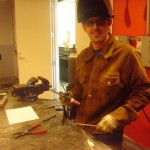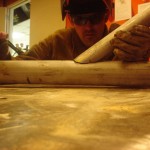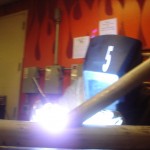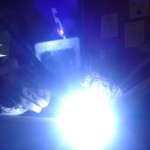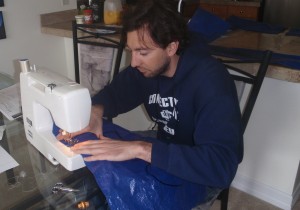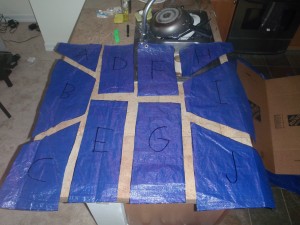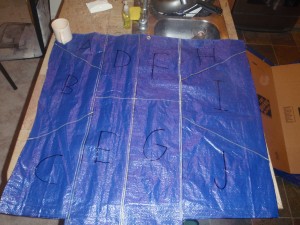May 12 2009
Learning to Weld
When I was growing up on the farm my dad would weld out in the shop all the time. And so I placed that activity in the same realm as everything else shop-related: loud, dirty, greasy, uncomfortable, involving flying hot shards of metal, and as a result I wanted nothing to do with it.
The boomerang of rebellious devil-may-care youth may fly far, but oh how often it eventually ends up right back where it started . . .
Since buying a boat I have become more and more fascinated with welding. I decided we needed a new radar arch to accommodate our future wind generator, solar panels, and radar antenna, and that I needed to learn how to weld so I could make it myself (of course, right? how else? everything always all by ourselves). Like Jon with his sailmaking–like everything else we’ve done–I went big all at once. I got a membership to the Tech Shop for $70/month, paid $50 for the introductory TIG welding class, and bought $250 worth of 20′ long sections of 2″ diameter 304 stainless steel pipe that were a real hassle to cart around on top of the xterra down the highway.
Maybe I used my learning to weld as an excuse to make a radar arch, or maybe I used the radar arch as an excuse to learn how to weld; either way at this point I’m in ‘ass deep to an elephant’, as jonny likes to say.
Turns out welding is absolutely amazing. Totally space-age modern-marvel out of this world activity. Welding is proof of how far science and technology has taken us. The welding machine that I use at the Tech Shop is a box approximately 1′ x 1.5′ x 2′ in size–much smaller than a suitcase. It plugs into the wall, and it hooks up to a gas tank. Then you grab a stylus-shaped “torch”, bring it close to a piece of metal, and press your foot on a pedal on the floor–and then would you believe that little machine ignites a 1/4″ cone of light hotter than the surface of the sun. That’s right: instant 10,000 degrees in the palm of your hand, a little mini sun that melts metal. (Crazy!) You have to wear a face mask too dark to see through in full daylight; without it the 10,000 degree arc will blind you in seconds. (Scary!) You have to wear gloves and cover all exposed skin, because it creates so much UV that it will give you a sunburn in a minute. (Hot!) When you hold that torch, your hand is 6″ away from a tiny 10,000 degree cone of orange and green plasma that dances on the metal. Now why didn’t they tell me THAT when I was younger? Who wouldn’t want to hold the sun and fire it up and melt some metal with 10,000 degrees of blinding light?
The type of welding I’m learning how to do is commonly referred to as TIG welding, which stands for “tungsten inert gas”. It’s more accurately called GTAW welding: “gas tungsten arc welding”. It is the most precise and most versatile, yet also slowest, most difficult, and least used form of welding. In TIG welding (as in other forms of welding), the metal is melted by heat created by an electric arc, EXACTLY like the static electric spark that jumps from your hand to the doorknob after you walk across a carpet with rubber soles. Welding is a sustained form of that static electric spark–if you could keep that spark going and then make it 100,000 times more powerful, you could be welding. In TIG welding, you connect the electricity to a thin, sharpened stake of tungsten (called the “electrode”) and then you bring the electrode really close to (but not touching!) the metal. Really close–like an 1/8″. Then you press the pedal to give it juice. And you have to hold it that exact distance while you move the torch along a path which you can hardly see because you have some dark-as-hell facemask on. And you have to move kind of fast but not too fast. And I haven’t even mentioned yet that with your left hand (the torch is in your right hand) you have to precisely jab (dab) a rod of “filler” metal into the melted pool of metal, to add metal to make the weld.
Get this: if the electrode touches the metal accidentally, or if you jab the filler rod into the electrode accidentally–both of which I do far too often–the event is punctuated by an even brighter spark and pop immediately followed by an accusatory green flame, which indicates that you have contaminated (i.e. fucked up) your weld with some of the metal from your electrode. At which point you have to CEASE AND DESIST, gingerly dismantle the torch (gingerly because it is still bloody hot, remember), and take your tungsten electrode over to the grinder to grind a fresh new uncontaminated tip onto it.
The whole thing is really hard. It’s really, really damn hard. It’s not hard to make any old arc, it’s not hard to melt any old metal. But it’s hard to get a result that doesn’t look like cyclops went wild on your metal with his phaser eye–I’m talking all black and gobby and bubbly and smoking crappy. And in welding (like in climbing), if it looks bad, it probably is bad: weak and worthless. Why is it so hard? There are tons of different settings, and it’s hard to tell which setting is having what effect. That little suitcase of a welding box is a freaking computer with a gazillion different options and blinking lights and whatnot. And then you have to have super fine motor skills to be able to hold both the torch and the filler rod so steady, and move them so quickly yet precisely, so close to the metal, all while you play this foot pedal to control how many thousands of degrees of heat you’re pumping into a tiny spot on the metal. And all metal is different, and different thicknesses need different settings, and each different joint requires a different technique . . .
All of which makes this radar-arch project daunting. I don’t want to add some ugly weak heavy janky piece of shit to the back of our boat now, do I? I agonized for months over what diameter and thickess and type of pipe to use, and how to join them, and where the support struts should go, and the moment of truth is coming in a day or so and I hope that it isn’t all shitty and stupid looking. I’ve spent a fair bit of time at the tech shop welding practice sections of tubing, and even at my best they are still black and ugly and melty. (You might well guess that at this point “ass deep to an elephant” may be too deep for me.) But I’m not getting much better and I don’t know what else to change and it’s time to move forward with this project and I think that my welds might be good enough. So tomorrow jonny and I go to the tech shop to make the first real welds on the actual radar arch. I KNOW they are going to be ugly. I’m hoping that they will at least be acceptably strong. I’ll post some pictures, regardless of how dissatisfied I am (especially now that I’ve laid the groundwork about how impossibly difficult it is :-). But damn! no matter what welding is a totally amazing thing that now I can (kind of) do!
*addition note: Pictures are complements of Jonny; I still have to add some shots of the resulting welds
